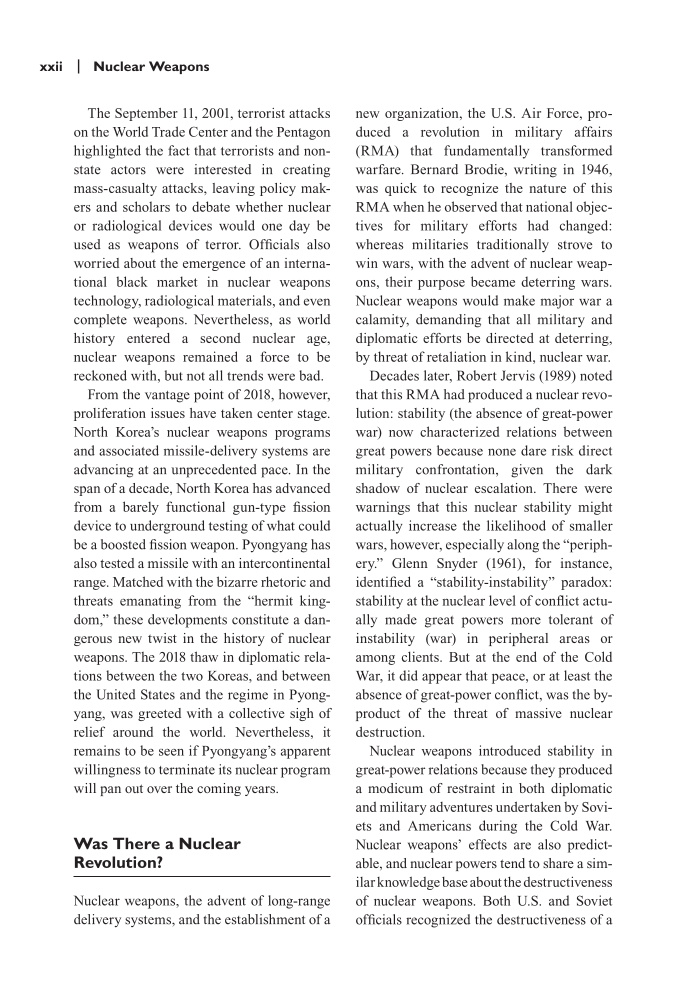xxii | Nuclear Weapons The September 11, 2001, terrorist attacks on the World Trade Center and the Pentagon highlighted the fact that terrorists and non- state actors were interested in creating mass-casualty attacks, leaving policy mak- ers and scholars to debate whether nuclear or radiological devices would one day be used as weapons of terror. Officials also worried about the emergence of an interna- tional black market in nuclear weapons technology, radiological materials, and even complete weapons. Nevertheless, as world history entered a second nuclear age, nuclear weapons remained a force to be reckoned with, but not all trends were bad. From the vantage point of 2018, however, proliferation issues have taken center stage. North Korea’s nuclear weapons programs and associated missile-delivery systems are advancing at an unprecedented pace. In the span of a decade, North Korea has advanced from a barely functional gun-type fission device to underground testing of what could be a boosted fission weapon. Pyongyang has also tested a missile with an intercontinental range. Matched with the bizarre rhetoric and threats emanating from the “hermit king- dom,” these developments constitute a dan- gerous new twist in the history of nuclear weapons. The 2018 thaw in diplomatic rela- tions between the two Koreas, and between the United States and the regime in Pyong- yang, was greeted with a collective sigh of relief around the world. Nevertheless, it remains to be seen if Pyongyang’s apparent willingness to terminate its nuclear program will pan out over the coming years. Was There a Nuclear Revolution? Nuclear weapons, the advent of long-range delivery systems, and the establishment of a new organization, the U.S. Air Force, pro- duced a revolution in military affairs (RMA) that fundamentally transformed warfare. Bernard Brodie, writing in 1946, was quick to recognize the nature of this RMA when he observed that national objec- tives for military efforts had changed: whereas militaries traditionally strove to win wars, with the advent of nuclear weap- ons, their purpose became deterring wars. Nuclear weapons would make major war a calamity, demanding that all military and diplomatic efforts be directed at deterring, by threat of retaliation in kind, nuclear war. Decades later, Robert Jervis (1989) noted that this RMA had produced a nuclear revo- lution: stability (the absence of great-power war) now characterized relations between great powers because none dare risk direct military confrontation, given the dark shadow of nuclear escalation. There were warnings that this nuclear stability might actually increase the likelihood of smaller wars, however, especially along the “periph- ery.” Glenn Snyder (1961), for instance, identified a “stability-instability” paradox: stability at the nuclear level of conflict actu- ally made great powers more tolerant of instability (war) in peripheral areas or among clients. But at the end of the Cold War, it did appear that peace, or at least the absence of great-power conflict, was the by- product of the threat of massive nuclear destruction. Nuclear weapons introduced stability in great-power relations because they produced a modicum of restraint in both diplomatic and military adventures undertaken by Sovi- ets and Americans during the Cold War. Nuclear weapons’ effects are also predict- able, and nuclear powers tend to share a sim- ilar knowledge base about the destructiveness of nuclear weapons. Both U.S. and Soviet officials recognized the destructiveness of a
Document Details My Account Print multiple pages
Print
You have printed 0 times in the last 24 hours.
Your print count will reset on at .
You may print 0 more time(s) before then.
You may print a maximum of 0 pages at a time.




































































































































































































































































































































































































